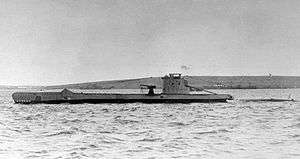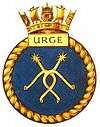HMS Urge
 HMS Urge | |
| History | |
|---|---|
| Class and type: | U-class submarine |
| Name: | HMS Urge |
| Builder: | Vickers Armstrong, Barrow-in-Furness |
| Laid down: | 30 October 1939 |
| Launched: | 19 August 1940 |
| Commissioned: | 12 December 1940 |
| Fate: | Sunk 29 April 1942 |
| Badge: |
 |
| General characteristics | |
| Displacement: |
|
| Length: | 58.22 m (191 ft) |
| Beam: | 4.90 m (16 ft 1 in) |
| Draught: | 4.62 m (15 ft 2 in) |
| Propulsion: |
|
| Speed: |
|
| Complement: | 27–31 |
| Armament: |
|
HMS Urge was a British U-class submarine, of the second group of that class, built by Vickers Armstrong, Barrow-in-Furness. She was laid down on 30 October 1939 and was commissioned on 12 December 1940. She is the only Royal Navy ship to have borne the name. Urge spent most of her career operating in the Mediterranean, where she damaged or sank a number of mostly Italian warships and merchant vessels. She was lost with all hands on 29 April 1942. There are several theories about her final fate. The long-held official view is that it is most likely that she was lost to a mine off Malta, a view re-confirmed in April, 2016. Other theories suggest she was sunk by direct enemy action, the most common that she was lost to an Italian air attack off Libya, but this now appears unlikely.
The boat was adopted and partially funded by the people of the Welsh town Bridgend as a result of the national "warship week" in 1941.[1]
Career
Prior to deployment to the Mediterranean, Urge sank the Italian tanker Franco Martelli in April 1941 whilst in the Bay of Biscay on passage from the UK to Gibraltar. Urge also damaged the Italian passenger ship Aquitania, and the Italian merchant ship Marigola. Marigola was already grounded after being torpedoed by aircraft on 24 September 1941. Then on 13 December, Urge torpedoed and damaged the Italian battleship Vittorio Veneto during the operations around the First Battle of Sirte. On 1 April 1942 Urge torpedoed and sank the Italian light cruiser Giovanni delle Bande Nere.
Urge was one of the first British submarines to land commandos by canoe (or folding kayak), and a number of successful commando raids were launched from her. These raids targeted enemy infrastructure such as railways and pioneered techniques used in later SBS work. However, special operations were hazardous, and in October 1941 a member of Urge's crew was lost to enemy fire when attempting to rescue an Allied agent from shore. On other occasions enemy patrol activity or traps were a frequent risk to landing operations.
Urge's torpedoes were sighted and avoided, suffered gyro failures, or otherwise failed to hit the target on a number of occasions including attacks on the Italian merchant vessel Capo Orso, the Italian tankers Superga and Pozarica, the Italian destroyer Alpino, the German merchant Ingo, the Italian heavy cruiser Bolzano, and the Italian troop transport Victoria. Urge also unsuccessfully attacked an unidentified armed merchant cruiser south of the Strait of Messina, subsequently attacking it with gunfire on the surface, but breaking off the attack due to accurate return fire.[2]
Loss
Urge left Malta on 27 April 1942. She failed to arrive at Alexandria on 6 May 1942 and was reported overdue on that day. Official sources have long attributed her loss to a mine outside Malta, which most historians continue to believe is the most likely cause of her loss. Minesweeping off Malta was severely restricted at the time following heavy air attacks. In April 2016 the Naval Historical Branch of the Ministry of Defence re-considered all available evidence and re-confirmed this position (see below).
This re-confirmation suggests that caution is needed when considering any alternative claims. One of these is that on 29 April Urge attacked the Italian sailing vessel San Giusto off Ras Hilal; in the immediate area there was a small convoy of three German MFPs, escorted by an Italian CR.42 biplane. As Urge supposedly attacked San Giusto, the biplane reportedly dropped two small bombs (but did not claim any sinking). However, the submarine would not have had enough speed to reach this area in the time available, which was in any event off its course set out in its sailing orders. Other weaknesses of the Ras Hilal theory include that the submarine sighting report was not verified, no Italian biplane ever achieved such a sinking, and the bombs involved would have been too small to damage a submarine. It also remains unlikely that Urge would have surfaced in daylight, particularly not to attack such a small target while on passage, or that an experienced crew used to avoiding fast German fighter planes would have failed to detect and avoid an Italian biplane.[3] No theory relating to Urge's loss has been conclusively proved.
Wreck
On 29 April 2015, it was reported that Jean-Pierre Misson claimed to have found the wreck of Urge on sonar recordings taken off the coast of Libya at Marsa el Hilal.[4] This is not supported by physical evidence other than sonar such as photographs or material from a wreck. If the images show an object, and if that object is a wreck, it may well be that of a U boat (U205) known to have sunk in the area. The claim that the images are of HMS Urge's wreck received some publicity but is not supported by analysis by the UK Government which is recorded below.
In April, 2016 the Naval Historical Branch of the Ministry of Defence endorsed the following paragraph by a naval historian relating to the possible causes of HMS Urge's loss:
It is not known with certainty how HMS Urge was lost, having sailed from Malta to Alexandria on 27th April, 1942. At the time of loss, the official view was that it was most likely that HMS Urge struck one of a number of mines which were laid by Axis forces at that time in the approaches to Malta. This remains the most likely cause of loss on the available evidence, although until the wreck of the submarine is found and positively identified other causes cannot be ruled out. Those other causes include the possibility of attack from Axis submarines or a depth charge attack by surface ships, although no Axis claim was made at the time. Although unlikely, there is a possibility that an accident could have caused the loss. Finally, there has recently been media interest in a claim of discovery of HMS Urge's wreck off the Libyan coast, based on a sonar image and a report of an attack by an Italian aircraft on a submarine. The evidence around this claim has been evaluated by the relevant UK Government historical authorities at the Naval Historical Branch of the Ministry of Defence, and is not considered sufficiently strong or credible to disrupt the official view that the most likely cause of loss was to a mine near Malta. It appears impossible that HMS Urge could have reached the site of the object discovered off Libya at the time of the purported attack at her speed in the sailing time available, and unlikely that she would have taken the risk of departing from her ordered course even if it had been possible. The inconclusive nature of the reports of the purported attack, and the lack of evidential weight of the sonar images of the object pending any photographic images or external visual evidence, are additional factors which have been taken into account. At this time therefore, the official view is that no claim of discovery of HMS Urge has been substantiated, and it remains most likely that the wreck of HMS Urge lies near Malta as a result of loss to a mine. For this reason, and as a sign of respect for the crew of HMS Urge, and their families, any suggestion that she was lost in another location or that her wreck has been discovered should be not be presented as fact. This is especially so in the absence of official recognition or acknowledgement by family representatives.
Notes
- ↑ BBC News - Missing submarine found
- ↑ HMS Urge, Uboat.net
- ↑ Submarine losses 1904 to present day, RN Submarine Museum, Gosport.
- ↑ WWII submarine funded by people of Welsh town is found more than SEVENTY years after it vanished
References
- Colledge, J. J.; Warlow, Ben (2006) [1969]. Ships of the Royal Navy: The Complete Record of all Fighting Ships of the Royal Navy (Rev. ed.). London: Chatham Publishing. ISBN 978-1-86176-281-8. OCLC 67375475.
- Hutchinson, Robert (2001). Jane's Submarines: War Beneath the Waves from 1776 to the Present Day. London: HarperCollins. ISBN 978-0-00-710558-8. OCLC 53783010.
- http://www.walesonline.co.uk/news/local-news/wwii-submarine-funded-people-welsh-9144522#rlabs=2
